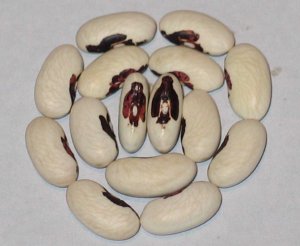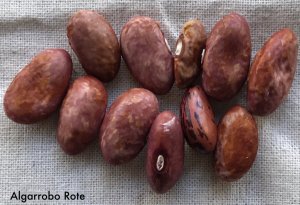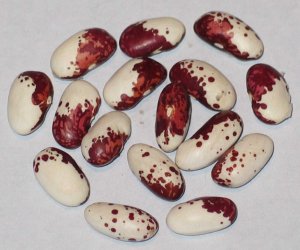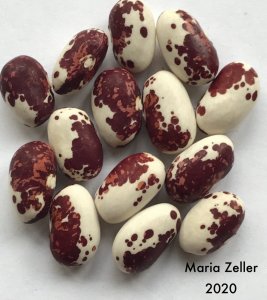Zeedman
Garden Master
Stretching the definition of "bean" a little further.
Gigandes - Greek runner bean, from a Gardenweb member in Alabama 2012. The largest bean of any kind that I grow; outstanding as a ripe shelly. Initially it under-performed here, I hoped that successive generations would be better adapted. That appeared to be the case the second year, which produced more than twice as much... so my hopes were up for this year, and I planted a 40' row. After great germination, the plants just sat there for most of the summer!?? The limas & pole beans adjacent to them grew normally. I have no idea what caused this; although runner beans may not set pods in hot weather, they've always grown & bloomed vigorously. The plants recovered somewhat in late summer, began climbing in late August, and produced 33 dry seeds before frost - which at least replaces what I to replanted with fresh seed.
Insuk's Wang Kong - heirloom from Gardenweb member Jim Wright in 2007. "Insuk" is his Korean wife's nickname, "Wang Kong" means "king bean". A red-flowered Scarlet Runner type, with a mix of all-black seeds, and seeds that are mostly purple, with black spots (a white-seeded impurity was successfully rogued out in the first generation). This was the 4th generation, and the bean has always been highly vigorous, with good heat tolerance for a runner bean, and a highly prolific dry seed producer. My last grow out produced over 5# of seed from a 30' row. The entire production this year, from a 27' row, is in the photo - and they are about 2/3 the size they should be. Like Gigandes, after great germination, they just sat there... but unlike Gigandes, they never recovered. Granted, they were initially choked by intensive weed pressure; but the row was cleaned in early July. Two gardens 6 miles apart; Gigandes from transplants at home, Insuk's direct seeded in the rural garden. I haven't a clue what could cause such severe stunting in both runner beans, and affect nothing else.
Like Gigandes, after great germination, they just sat there... but unlike Gigandes, they never recovered. Granted, they were initially choked by intensive weed pressure; but the row was cleaned in early July. Two gardens 6 miles apart; Gigandes from transplants at home, Insuk's direct seeded in the rural garden. I haven't a clue what could cause such severe stunting in both runner beans, and affect nothing else.
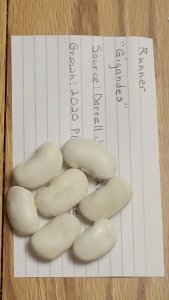
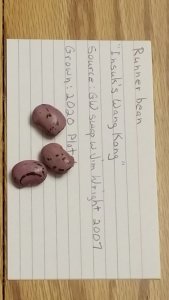
Shiraz - from @aftermidnight, a purple snow pea developed in the U.K.. This was the only pea I grew this year, because I wanted to ensure purity. The 2013 seed had almost 90% germination. The plants were vigorous, produced a lot of peas, and the mice which plagued my home garden were completely uninterested in them. DW & I loved the flavor, and snacked on the pods for nearly a month. Planted May 31st, they prospered in the summer weather, and produced 24 ounces of dry seed.
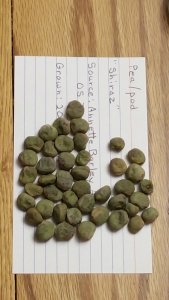
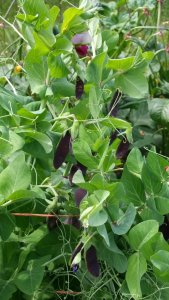
Adzuki "Buff" - from a Canadian SSE member in 2006, originally from a deceased collector in Arkansas. 100 days. True upright bush habit, with racemes of bright yellow flowers, and slim pods that turn tan when dry. An unusual color for adzuki; smaller seeds, and ripens much earlier than most red-seeded varieties. Extremely easy to shell. Normally a fairly high yielder; but like everything else in the rural garden, it was stunted by heavy weed pressure. Along with the 2 other varieties below, they were the last plants to get weeded in late July. They did recover late & set pods, I'm actually impressed that the plants produced even 1 ounce of dry seed under those conditions. The second photo below is the normal appearance of the bushes, in a previous year.
Black Kali Gram - a.k.a. "urd", from a late SSE member in Colorado, who stated that in Nepal (where it was collected) the dry beans were often fermented. 75 days & up. Sprawling, non-twining plants, with inconspicuous yellow-green flowers. Clusters of 4-6 tiny 2" pods turn black when dry. The powder-black seeds are smaller than green gram, 6-9 per pod... the stunted plants produced 1 ounce of seed before frost. This particular race is a mixture of both smooth-podded and hairy-podded plants, but the seeds are indistinguishable. In local ethnic groceries, these beans are sold hulled & split, as Urad Dal.
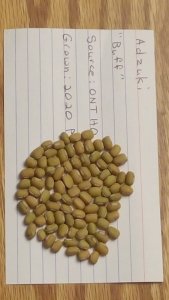
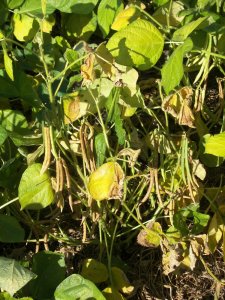
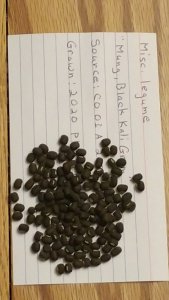
Hyacinth bean, "India Bush" - from an SSE member, who stated they were given to them by a neighbor from India. That neighbor moved before the seed was sent to me; I suspect - but cannot prove - that this is similar/identical to "Valor Bean Lakshmi" sold by Seeds of India. True upright bush habit, although they might tip under pod load late in the season. Unlike most hyacinth beans, this variety is day-neutral, and flowers incredibly quickly in my latitude - 30 days after planting! The spikes of large white flowers are followed by clusters of flattened, dark green 3" pods. The cooked pods are like bean-flavored snow peas, and are borne all summer if kept picked. When dry, the pods shrink down over the seeds, and are difficult to shell. Like the adzuki above, the photo of the plants is of normal growth, taken in a previous year... and like the other varieties in that plot, it recovered late from stunting & produced about 1 ounce of dry seed before frost.
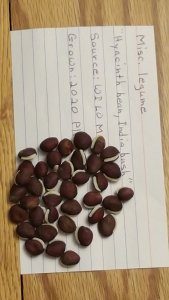
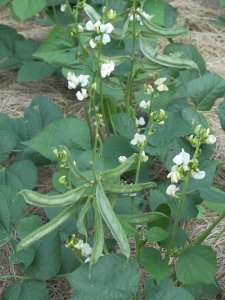
Gigandes - Greek runner bean, from a Gardenweb member in Alabama 2012. The largest bean of any kind that I grow; outstanding as a ripe shelly. Initially it under-performed here, I hoped that successive generations would be better adapted. That appeared to be the case the second year, which produced more than twice as much... so my hopes were up for this year, and I planted a 40' row. After great germination, the plants just sat there for most of the summer!?? The limas & pole beans adjacent to them grew normally. I have no idea what caused this; although runner beans may not set pods in hot weather, they've always grown & bloomed vigorously. The plants recovered somewhat in late summer, began climbing in late August, and produced 33 dry seeds before frost - which at least replaces what I to replanted with fresh seed.
Insuk's Wang Kong - heirloom from Gardenweb member Jim Wright in 2007. "Insuk" is his Korean wife's nickname, "Wang Kong" means "king bean". A red-flowered Scarlet Runner type, with a mix of all-black seeds, and seeds that are mostly purple, with black spots (a white-seeded impurity was successfully rogued out in the first generation). This was the 4th generation, and the bean has always been highly vigorous, with good heat tolerance for a runner bean, and a highly prolific dry seed producer. My last grow out produced over 5# of seed from a 30' row. The entire production this year, from a 27' row, is in the photo - and they are about 2/3 the size they should be.
 Like Gigandes, after great germination, they just sat there... but unlike Gigandes, they never recovered. Granted, they were initially choked by intensive weed pressure; but the row was cleaned in early July. Two gardens 6 miles apart; Gigandes from transplants at home, Insuk's direct seeded in the rural garden. I haven't a clue what could cause such severe stunting in both runner beans, and affect nothing else.
Like Gigandes, after great germination, they just sat there... but unlike Gigandes, they never recovered. Granted, they were initially choked by intensive weed pressure; but the row was cleaned in early July. Two gardens 6 miles apart; Gigandes from transplants at home, Insuk's direct seeded in the rural garden. I haven't a clue what could cause such severe stunting in both runner beans, and affect nothing else.

Shiraz - from @aftermidnight, a purple snow pea developed in the U.K.. This was the only pea I grew this year, because I wanted to ensure purity. The 2013 seed had almost 90% germination. The plants were vigorous, produced a lot of peas, and the mice which plagued my home garden were completely uninterested in them. DW & I loved the flavor, and snacked on the pods for nearly a month. Planted May 31st, they prospered in the summer weather, and produced 24 ounces of dry seed.


Adzuki "Buff" - from a Canadian SSE member in 2006, originally from a deceased collector in Arkansas. 100 days. True upright bush habit, with racemes of bright yellow flowers, and slim pods that turn tan when dry. An unusual color for adzuki; smaller seeds, and ripens much earlier than most red-seeded varieties. Extremely easy to shell. Normally a fairly high yielder; but like everything else in the rural garden, it was stunted by heavy weed pressure. Along with the 2 other varieties below, they were the last plants to get weeded in late July. They did recover late & set pods, I'm actually impressed that the plants produced even 1 ounce of dry seed under those conditions. The second photo below is the normal appearance of the bushes, in a previous year.
Black Kali Gram - a.k.a. "urd", from a late SSE member in Colorado, who stated that in Nepal (where it was collected) the dry beans were often fermented. 75 days & up. Sprawling, non-twining plants, with inconspicuous yellow-green flowers. Clusters of 4-6 tiny 2" pods turn black when dry. The powder-black seeds are smaller than green gram, 6-9 per pod... the stunted plants produced 1 ounce of seed before frost. This particular race is a mixture of both smooth-podded and hairy-podded plants, but the seeds are indistinguishable. In local ethnic groceries, these beans are sold hulled & split, as Urad Dal.



Hyacinth bean, "India Bush" - from an SSE member, who stated they were given to them by a neighbor from India. That neighbor moved before the seed was sent to me; I suspect - but cannot prove - that this is similar/identical to "Valor Bean Lakshmi" sold by Seeds of India. True upright bush habit, although they might tip under pod load late in the season. Unlike most hyacinth beans, this variety is day-neutral, and flowers incredibly quickly in my latitude - 30 days after planting! The spikes of large white flowers are followed by clusters of flattened, dark green 3" pods. The cooked pods are like bean-flavored snow peas, and are borne all summer if kept picked. When dry, the pods shrink down over the seeds, and are difficult to shell. Like the adzuki above, the photo of the plants is of normal growth, taken in a previous year... and like the other varieties in that plot, it recovered late from stunting & produced about 1 ounce of dry seed before frost.




